I had to do this scenario, because I had made the buildings. Sometimes it happens that way round.
Someone in my wargame club had a load of the “Tomb King” figures by Citadel. These were fantasy animated skeletons in ancient Egyptian costumes. Since I didn’t actually have any Egyptian figures, I recruited him for the game. I would mount a raid on Egypt from the sea using my Mycenaean figures, and he would provide the defenders. Homers’s Odyssey has a tale in it of a raid on Egypt mounted by Menelaos. Everything goes wrong in that raid too.
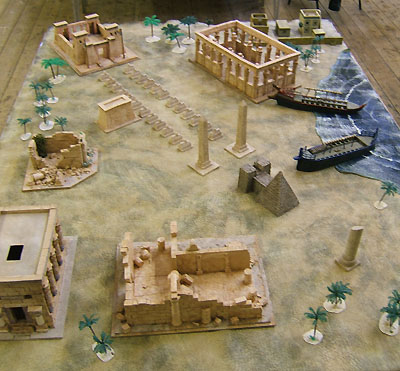
The table, photographed just before the figures were added at the game’s start.
I don’t expect anyone to duplicate this scenario exactly in its every detail. In fact, the scenery could be changed very radically, and the setting changed to one entirely different – perhaps an attack on a railway goods yard in World War Two by Yugoslavian partisans. What matters is the basic concept of the scenario which makes it a good game. I shall continue describing it in terms of a raid by Mycenaeans on Egypt, but in your head you can translate it to some other world.
Basic idea of the scenario
The game is designed for three players. Two players command one ship-load of raiders each, and the third player commands the defenders, and acts as a sort of referee, also controlling villagers etc. The defender deploys hidden. The attacking players are in competition with each other to gain the most loot. One theme of the scenario is the balance between competition and co-operation. The scenario is set up to punish players who fail to co-operate.
On one side of the table is a distraction: a village populated by local civilians. There is loot to be had here, but not great quantities of it. The locals will flee, defend each other, harass raiders by throwing stuff from rooftops, shut themselves in their homes, and such like to entertain the player distracted by them.
In the two far corners of the table, are the rich spoils, hidden in buildings. In my version, the pylon temple had a big pile of treasure in it, collected by the evil undead, and in the roofed temple in the other corner there was a rich tomb, which included a sarcophagus inside which was a mummy which, if destroyed, would destroy the commander of the undead, and free the area from his curse. In a different setting this could be replaced with the self-destruct mechanism for the Bond villain’s base, or whatever.
The raiding parties are in competition with each other, but to some degree they should co-operate, because if they don’t, they may be defeated piecemeal. On one side of the table (away from the village), the defender deploys most of his forces. These should consist of enough low-quality troops to defeat one of the two raiding parties by swamping it with numbers. Since they are low-quality, many of them will be defeated, which is fun for the attacking player. The player on the other side of the table may allow his rival to be defeated, but if he does, then he is on his own.
Since I used ships as the means of arrival, I could also make them part of the scenario’s end. To leave, the raiders must get back on to their ships, and it takes a large proportion of the men in a raiding party to launch a ship. After defeating one raiding party, the defenders may well pursue a fleeing group of raiders back to the ships, and destroy first one and then the other ship, cutting off all the survivors. An alternative to a ship might be a narrow pass, a teleporter, a helicopter, or whatever else suits the setting chosen.
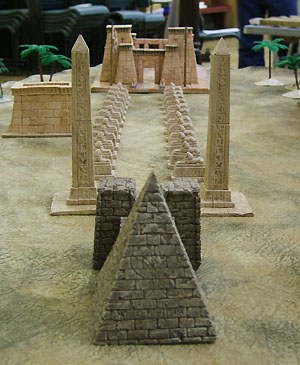 |
Just before I took this photograph, as I was talking to someone, a passer-by decided to ‘straighten’ the Nubian tomb in the foreground. Oh well. In Egypt, there were some avenues of sphinxes like this that literally were miles long. |
| Here we see the distraction: the village. Villagers potter around. There are laden camels and white bulls to steal, men women and children to kill or capture, and jars of olive oil, baskets of bread and the like to loot too. Pots, querns stones, buckets and the like can be thrown down at raiders who are trying to bash in doors or carry off relatives. In fact, as referee I was quite prepared to have the townsfolk be helpful if approached in the right way. They might be glad of warriors who could rid them of the curse of the Tomb Kings. Depicted on-table was just one corner of a much larger town. |
 |
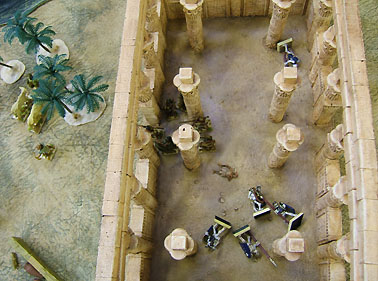 | To give the raider on the lightly-defended side of the table the illusion that he was behaving in a military manner, I had five skeleton tomb warriors ambush him in a derelict temple. These were quickly defeated. You can also see a dead Egyptian warrior who was included as a clue that the locals were under some alien threat (and therefore might appreciate help rather than be another foe to fight).
|
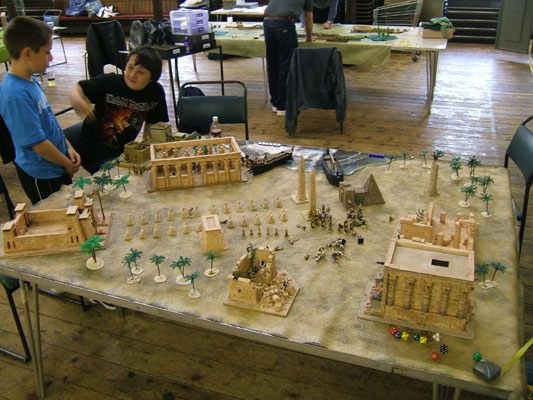
In playtest, the ship nearer the village (red) was commanded by two boy players, seen here. They had a fine time looting the village, and rejoiced to see the other player being defeated by great numbers of undead, including the powerful undead leader.
In this shot, the blue ship commander’s contingent has already been defeated, and is routing back to its ship. He had spread his men out across his half of the table and then they got charged from the ruined temples either side of the roofed temple of Anubis and Sobek. He might have had warning of this, because early on he found a wounded Egyptian soldier lying on the ground, but before the poor man could make himself understood, javelins were thrown into him and finished him off. The other (red) ship lies almost completely undefended (its leader stayed aboard – for such cowardice he will doubtless not be granted much of a share of the loot).
Out of consideration for my opponents’ view of the table, I hid my dice behind a temple.
Possibly I should darken the bases of my model palm trees.
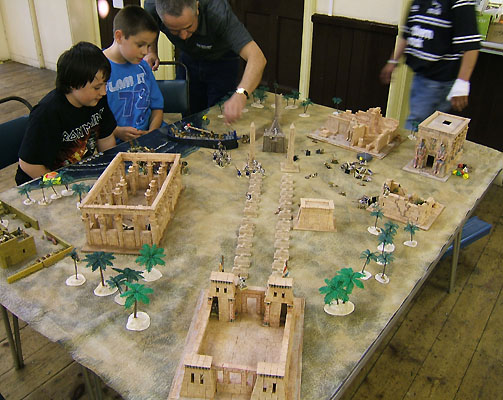
In this shot, you see what happened next. The routed contingent’s leader ran straight to the other ship and got on board. His men mostly got on board their own ship, and all the while took more and more casualties from the arrows and spears of their pursuers. By this time they were too few to launch their ship. One tried to set fire to his own ship, but was shot down before he did this. Others jumped overboard and swam for the other ship, and two or three made it.
 | Meanwhile, the red ship’s commanders realised the danger and hastened back to their ship, but despite the urgency, bothered to bring with them stolen animals, captives, and loot, and load these aboard. A thin line of spearmen stood between the advancing undead and the red ship, and these just managed to buy enough time to launch the ship. The first four attempts to launch were failures, and all the time men helping in the launch were being attacked. This delay enabled one man to run all the way back to the ship from the far corner of the table, so he was lucky. The ship eventually cleared the sandy beach and the many wounded men aboard made it out to sea, with others swimming after it, being shot at from the beach by skeletons that would not enter the water. The raid cost far more than it stole.
|
Forces
I was using my fast-play skirmish rules, in which a knight costs 3 points, a soldier 2 points and a peasant 1 point. These are referred to as “quality ratings” or QR.
Each ship had a hero commander (QR3), a hero spearman (QR3), six spearmen (QR2), six archers (QR2), four swordsmen (QR2), and six young javelin men (QR1). Opposing these was a QR4 lord of the undead, and about forty-eight QR1 skeleton followers, including a few with swords or maces, lots of spears, and lots of archers. This was enough to defeat one raiding party, but not two at once. Indeed, since the skeletons were of low quality, a well-led raiding party could have beaten them had it stayed in good formation and fought on good ground. In melee, the skeletons were no match for the Mycenaeans one-for-one, but they had a big advantage in an arrow-fight: I treated them as knights when it came to rolling damage against them, because I envisaged arrows passing harmlessly through their rib-cages most of the time, with just the occasional lucky shot taking off an arm or severing the spine.
The raiding parties were 24 men strong. I ruled that it took 14 men to launch a ship, and that an attempt to launch stood a fifty-fifty chance of success. You could choose to come up with a more sophisticated sliding scale, but I think that 14 out of 24 (between half and two-thirds) was the right proportion. This means that if a contingent breaks (loses all its morale), then it is likely to have a tough time launching.
| This was not the most easy game to transport. Here we see it all packed away afterwards. Normally, I get everything in a rucksack and I cycle home. Erm, can anyone give me a lift? |
 |
 |
Here we see some of the red ship’s men (commanded by the two boy players) making back with two prize white bulls. The most valuable thing they found in a house was a young woman, whom they shot dead in their enthusiastic blood lust. They are young, and they will learn. |
If you want to see more of these model temples, you’ll find close-ups of them, and text on how they were made here: making model Egyptian temples.